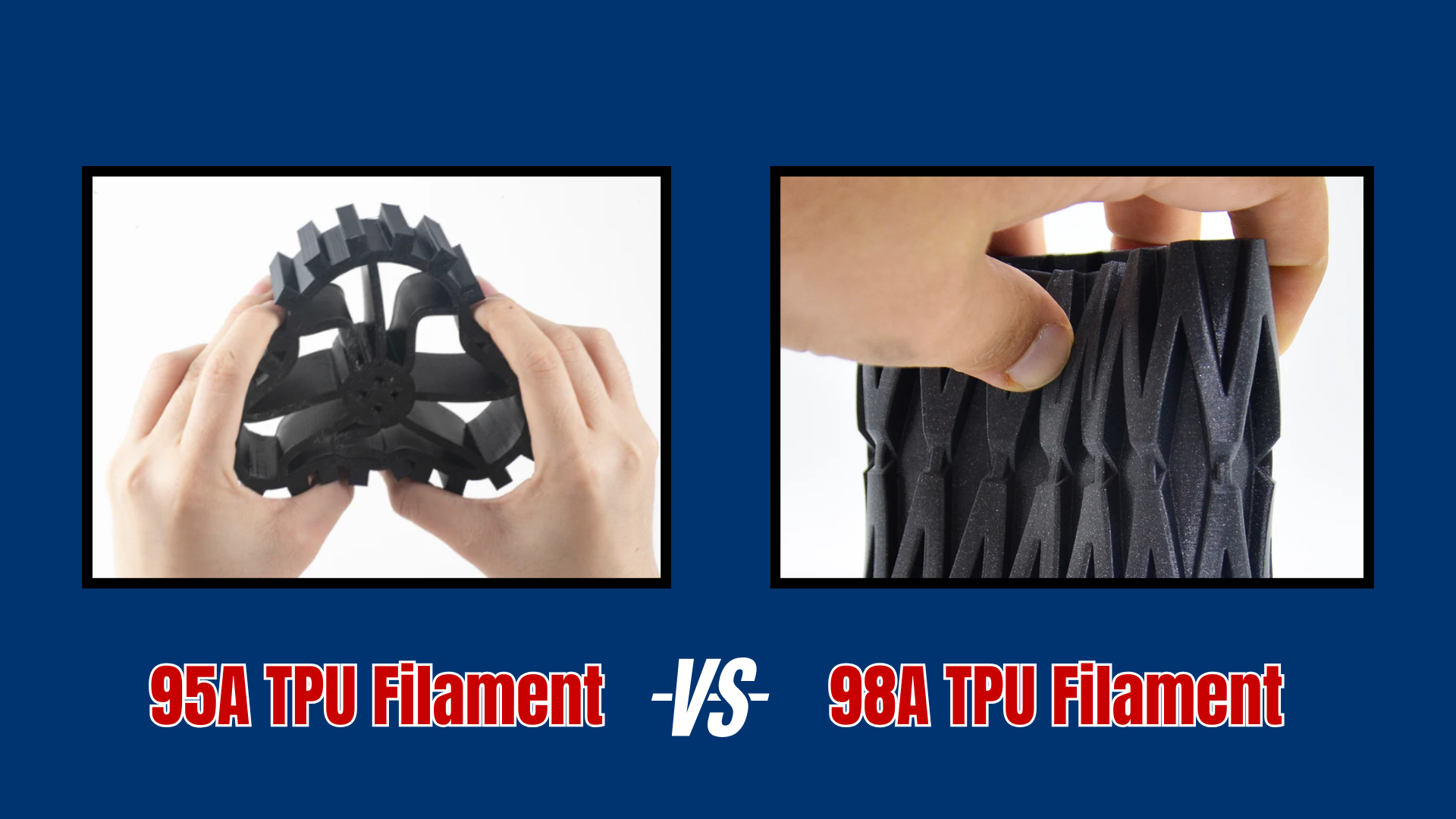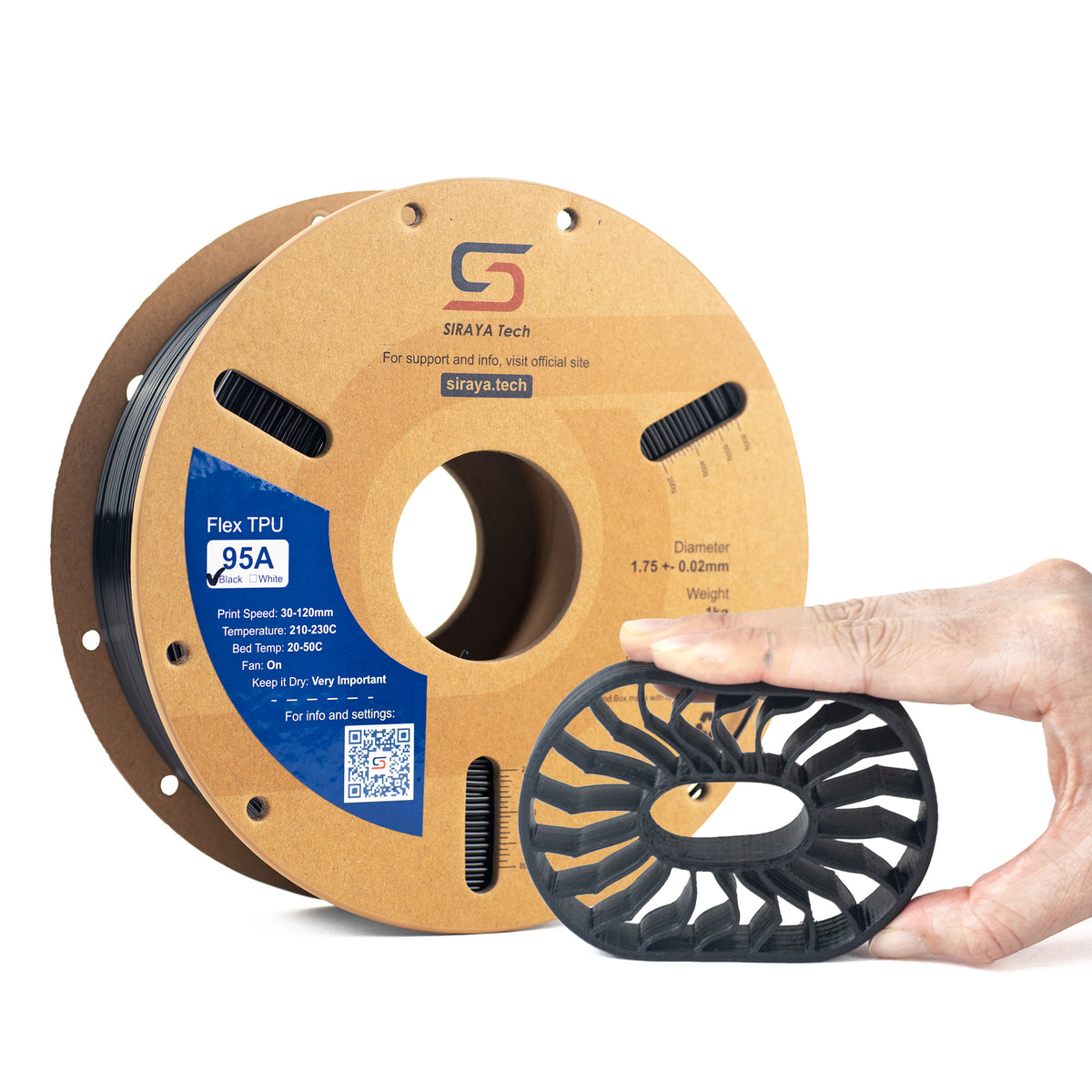If you’re trying to decide between 95A vs 98A TPU filament, you’re probably looking for the perfect balance between flexibility, strength, and ease of printing.
Both types are great for flexible 3D printing, but they behave differently depending on what you’re making. Let’s explore their differences so you can confidently choose the right one for your next print.
Keep reading to learn how to get the best results with flexible materials.
What Is TPU Filament and Why Does Shore Hardness Matter?
Before comparing 95A vs 98A TPU filament, it’s important to understand what TPU actually is.
TPU stands for Thermoplastic Polyurethane, a flexible yet durable material used for 3D printing parts that can bend, stretch, and return to shape.
The “A” in 95A or 98A refers to the Shore A hardness scale, a standardized test (ASTM D2240) that measures how resistant a material is to indentation.
Lower numbers mean softer, more flexible materials, while higher numbers mean stiffer, more rigid ones.
For example, Siraya Flex TPU - 95A offers a great middle ground between flexibility and strength, making it a solid choice for everyday prints.
📌 Learn more in What is TPU Filament to understand how it’s made and why it’s so popular in 3D printing.
95A vs 98A TPU Filament: Key Differences Explained
Both 95A and 98A TPU filaments are flexible, but they serve different purposes. The main differences are in flexibility, durability, and printability.
|
Feature |
TPU 95A |
TPU 98A |
|---|---|---|
|
Flexibility |
Softer and more elastic |
Stiffer and less flexible |
|
Durability |
Great for soft parts |
Better for strong, load-bearing parts |
|
Ease of Printing |
Can be tricky for beginners |
Easier to handle, less stringing |
|
Applications |
Phone cases, grips, gaskets |
Wheels, mechanical parts, joints |
If you want a flexible filament that’s easy to control, Siraya Flex TPU - 95A is a dependable option.
For projects that need more rigidity, Siraya PEBA Elastic 95A gives you that extra strength while keeping some flexibility.
You May Shop
How Flexible Is TPU 95A Compared to 98A?
TPU 95A feels soft and rubber-like, allowing it to stretch and bend easily without tearing. It’s perfect for parts that need to flex or absorb impact.
TPU 98A feels firmer and more controlled. It still bends but resists deformation, which is ideal for parts that need to hold their shape under pressure.
Printing Experience: Which Is Easier to Work With?

Printing flexible filaments can be challenging, especially for beginners. TPU 95A is softer and may require slower print speeds to prevent jams or stringing. It’s best printed on a direct-drive extruder for smoother feeding.
TPU 98A is slightly stiffer, making it easier to handle and less likely to cause printing issues. Most printers with a Bowden extruder can still print TPU 98A with some tuning, but softer filaments like 95A work best on direct-drive setups.
Typical printing temperatures for TPU range from 220°C to 250°C, depending on the brand and hardness. Softer TPUs often need slightly lower temperatures for smoother extrusion.
📌 Check out What is a Filament for a simple explanation of filament types and their unique properties.
Durability and Strength: Which TPU Holds Up Better?
Both 95A and 98A TPU filaments are strong, but they excel in different ways. TPU 95A is more elastic, which helps it resist tearing and stretching damage.
TPU 98A is tougher and more rigid, giving it better resistance to abrasion and wear. If your print needs to handle heavy use or mechanical stress, 98A is the better choice.
For even more durability, try Siraya Flex TPU - 64D, which offers enhanced stiffness with excellent impact resistance.
Best Uses for 95A vs 98A TPU Filament
Different projects require different hardness levels. Here’s when to use each type:
When to Choose TPU 95A
- ✅ Great for flexible parts like phone cases, seals, and grips
- ✅ Ideal for wearable items that need comfort and stretch
- ✅ Works well for shock-absorbing components
Try Siraya Flex TPU - 95A for reliable, balanced performance
When to Choose TPU 98A
- ✅ Perfect for functional parts like wheels, gears, or connectors
- ✅ Best for components that need strength and stability
- ✅ Great for prints that must hold their shape under pressure
Consider Siraya PEBA Elastic 95A for strong yet slightly flexible prints
How to Avoid Common TPU Printing Problems

Flexible filaments can be tricky, but a few small adjustments can make a big difference. Common problems include stringing, poor layer bonding, and uneven extrusion.
Here are some simple fixes:
- ✅ Print slowly, around 20–40 mm/s for better control
- ✅ Use a direct-drive extruder if possible
- ✅ Keep retraction settings low to avoid jams
- ✅ Make sure your nozzle and bed temperatures are properly tuned
If you still notice stringing, lower the print temperature slightly or reduce retraction distance.
For smoother results, try Siraya Flex TPU Air - 65A to 82A, which minimizes printing issues while maintaining flexibility.
Cost and Availability of TPU 95A and 98A
Both 95A and 98A TPU filaments are reasonably priced, with only small differences depending on the brand. They usually cost a bit more than standard PLA or PETG because of their flexibility and durability.
Both hardness levels are widely available from major 3D printing suppliers in the U.S. and globally, including online retailers and specialty material providers.
How to Choose Between 95A and 98A TPU Filament
If your project needs something soft, stretchy, and comfortable to handle, go with TPU 95A. It’s great for flexible parts that bend easily without losing shape.
If you need something tougher and more stable, TPU 98A is the better option. It’s easier to print and holds up better under pressure.
A quick guide to remember:
- ✅ TPU 95A = flexibility and comfort
- ✅ TPU 98A = strength and structure
For versatile performance, explore Siraya PEBA Air 70A to 95A, which offers a range of hardness options for precise control.
Conclusion
Choosing between 95A vs 98A TPU filament comes down to what your project needs most. TPU 95A offers more flexibility and stretch, while TPU 98A provides strength and structure. Both can deliver great results when printed correctly.
Explore Siraya’s TPU products like Flex TPU - 95A, Flex TPU Air - 65A to 82A, or PEBA Elastic 95A to find the perfect match for your next print.
Frequently Asked Questions About TPU Filaments
What is the difference between 90A and 98A TPU?
The difference lies in hardness. 90A TPU is softer and more flexible, while 98A TPU is firmer and stronger. 90A is better for soft, bendable parts, while 98A works best for functional pieces that need to hold shape.
What is the difference between TPU and TPU 95A?
TPU is the general material type, and TPU 95A refers to a specific hardness level. TPU 95A offers a balanced mix of flexibility and strength, making it one of the most versatile and popular types for 3D printing.
What is TPU 95A filament used for?
TPU 95A filament is used for flexible parts that need to bend or stretch without breaking. It’s commonly used for phone cases, seals, and shock-absorbing components.
Is TPU 95A good for beginners?
Yes, TPU 95A is a good starting point for those new to flexible filaments. It’s soft enough to show flexibility but not too soft to cause feeding issues. Beginners should print slowly and carefully adjust retraction settings for the best results.
How do I stop my TPU from stringing?
To reduce stringing, lower your print temperature slightly and use minimal retraction. Keep your nozzle clean and make sure your filament path is smooth. Slowing down the print speed also helps improve overall print quality.



